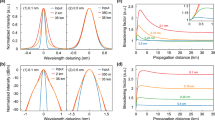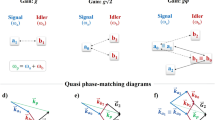Abstract
An insight into the signal gain in multiple four-wave mixing (MFWM) processes based on a cubic susceptibility medium is theoretically proposed and demonstrated. A dual-pumped fiber optical parametric amplification (FOPA) model is developed with the exact expressions for the signal gain and its 3-dB bandwidth successfully yielded.With these analytical expressions, we show that when pump-1 and pump-2 wavelengths tuned at 1549 and 1551.02 nm, the 3-dB bandwidth of the signal gain can be achieved at about 2253.4 nm theoretically by properly setting the pumped powers. Numerical simulations show that there is a small pinnacle emerging in the signal gain spectrum owing to the degenerate OPA process occurring. The proposed OPA model can find potential applications in all-optical wavelength conversion, optical amplifier, and all-optical sampling.
Similar content being viewed by others
References
Hansryd J, Andrekson P A, Westlund M, Li J, Hedekvist P O. Fiber-based optical parametric amplifiers and their applications. IEEE Journal on Selected Topics in Quantum Electronics, 2002, 8(3): 506–520
Sun J Q, Li H, Cheng Y, Li J. Tunable wavelength conversion of picosecond pulses based on cascaded sum- and difference-frequency generation in quasi-phase-matched LiNbO3 waveguides. Optics Communications, 2008, 281(23): 5874–5883
Jargon J A, Wu X, Choi H Y, Chung Y C, Willner A E. Optical performance monitoring of QPSK data channels by use of neural networks trained with parameters derived from asynchronous constellation diagrams. Optics Express, 2010, 18(5): 4931–4938
Van Erps J, Luan F, Pelusi M D, Iredale T, Madden S, Choi D Y, Bulla D A, Luther-Davies B, Thienpont H, Eggleton B J. High-resolution optical sampling of 640-Gb/s data using four-wave mixing in dispersion-engineered highly nonlinear As2S3 planar waveguides. Journal of Lightwave Technology, 2010, 28(2): 209–215
Torounidis T, Karlsson M, Andrekson P A. Fiber optical parametric amplifier pulse source: theory and experiments. Journal of Lightwave Technology, 2005, 23(12): 4067–4073
Zhao L, Sun J Q. Investigation of tunable trap filter utilizing intense signal four wave mixing model in highly non-linear fiber. Optics Communications, 2009, 282(14): 2975–2982
Gao M Y, Jiang C, Hu W S. Dual-pump broadband fiber optical parametric amplifier with a three-section photonic crystal fiber scheme. Proceedings of SPIE, 2005, 5623: 300–307
Liu X M, Zhou X Q, Lu C. Multiple four-wave mixing self-stability in optical fibers. Physical Review A, 2005, 72(1): 013811
Liu X M. Theory and experiments for multiple four-wave-mixing processes with multifrequency pumps in optical fibers. Physical Review A, 2008, 77(4): 043818
Zhao L, Sun J Q. Suppression of degenerate four-wave mixing in nondegenerate optical parametric amplifiers. Optical Engineering, 2008, 47(8): 085001
Cao H, Sun J Q, Huang D X. Unique dispersion effects on transmitting and amplifying of picosecond pulses in fiber optical parametric amplifiers. Proceedings of SPIE, 2005, 6019: 601931
Cao H, Sun J Q, Huang D X. Theoretical study on the signal pulse splitting phenomenon in continuous wave pumped fiber optical parametric amplifier. Proceedings of SPIE, 2005, 6019: 601930
Author information
Authors and Affiliations
Corresponding author
Rights and permissions
About this article
Cite this article
Zhao, L., Sun, J., Hu, Z. et al. Theoretical demonstration for signal gain in multiple four-wave mixing processes based on cubic susceptibility medium. Front. Optoelectron. China 3, 270–282 (2010). https://doi.org/10.1007/s12200-010-0106-9
Received:
Accepted:
Published:
Issue Date:
DOI: https://doi.org/10.1007/s12200-010-0106-9




